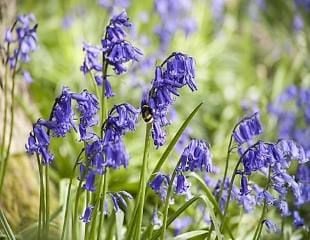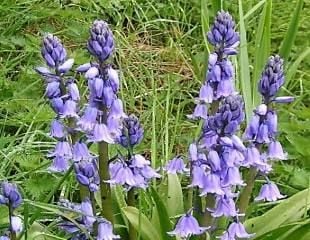How to Grow Bluebells



Key Facts:
Height:40cm
light: Full sun or shade
Soil Type: moist, well-drained
Maintenance:easy to grow, can be invasive
Special Features: An English native plant protected under the Wildlife and Countryside Act 0981
Bluebells are a perennial bulb which means they come back year after year
Bluebells carpet a woodland setting. They are quintessentially British woodland flowers, and about half the bluebells in the world grow in the UK.
Under the right conditions, Bluebells grow themselves, but they can be invasive. Bluebells grow well in wild or semi-wild settings with lots of room, such as a woodland. Most gardens are not large enough to accommodate a woodland area. They may look delicate, but Bluebells are fast to establish in an area, and this is an important point to consider when introducing them to your garden,.
An alternative to Bluebells, and which is less invasive, is the spring-flowering bulb Camassia. Although flowering a little later, late April onwards, it is far better behaved and more suited to smaller spaces.
From the conservation perspective, it is important to buy and plant only English Bluebells. There is an impostor, illustrated below, which is the Spanish bluebell. This variety is even more invasive and vigorous than the English variety. Unfortunately, the natural movement of pollen by bees will cross-pollinate with the English variety to contaminate the strain. This threatens the purity and longevity of the English bluebell, which is a more delicate, attractive flower. By checking you buy and plant only English bluebells, you help to support our native bluebell.
How and Where to Plant Bluebells
Key Facts:
Plant in part shade in moist soil
Plant in the green in spring
Plant in the Autumn as bulbs 10cms
For Bluebells to grow well, replicate their woodland conditions. This means part sun and part shade conditions, in soil which is moist and does not dry out during the summer.
Bluebells can be planted in the spring as ready plants, called "in the green." These garden-ready plants should be planted at a depth so that the soil is similar to when they were growing in the ground. The soil should cover all the white parts of the stem underground. Planting in the green is the easiest way to establish Bluebells.
Bluebells planted in the Autumn are bulbs and should be around 10cms deep, pointed end uppermost. This will be about 3 times the depth of the bulb and it is important to water well after planting. (How to plant spring bulbs.) A mulch, ideally of leaf mould, will help retain moisture.
Bluebells look nice planted under trees and appreciate the shade from the trees. Only plant Bluebells where there is a good sized area which they can colonise without spoiling the garden and becoming a pest plant. If Bluebells are taking over, the only way to eradicate them is to dig them out, weedkillers are not found to be very effective. Dig out when the Bluebells are in bloom, so you can dig down and locate the bulb. It is also best not to compost the bulbs.
Bluebells Are Good Source of Nectar
Bluebells are a good source of nectar for bees. Bees love Bluebells because they are attracted to blue flowers, the trumpet shapes and the very sweet nectar Bluebells produce. Don't take my word for it, pause to watch this short video of a hungry bee feeding away.
How to tell English Bluebells from Spanish Bluebells
English Bluebell Hyacinthoides non-scripta

Spanish Bluebell Hyacinthoides hispanica

Although at first glance English and Spanish Bluebells look similar, a simple check will make it easy to tell them apart. There are a few characteristics to be checked to ensure you a planting the real deal.
English Bluebells
Delicate drooping flower head
Faint Perfume
Narrow flowers which curl back
Tiny white flower inside the bell
Spanish Bluebells
Upright Flowers and stems
No Scent
Flowers more of a conical shape
Blue Pollen


Green wheelbarrow Bluebells are easy to grow, possibly too easy as they can be invasive. Note: All parts of the bluebell plant contain toxic glycosides that are poisonous to humans, dogs, horses and cattle and can cause stomach upset.
